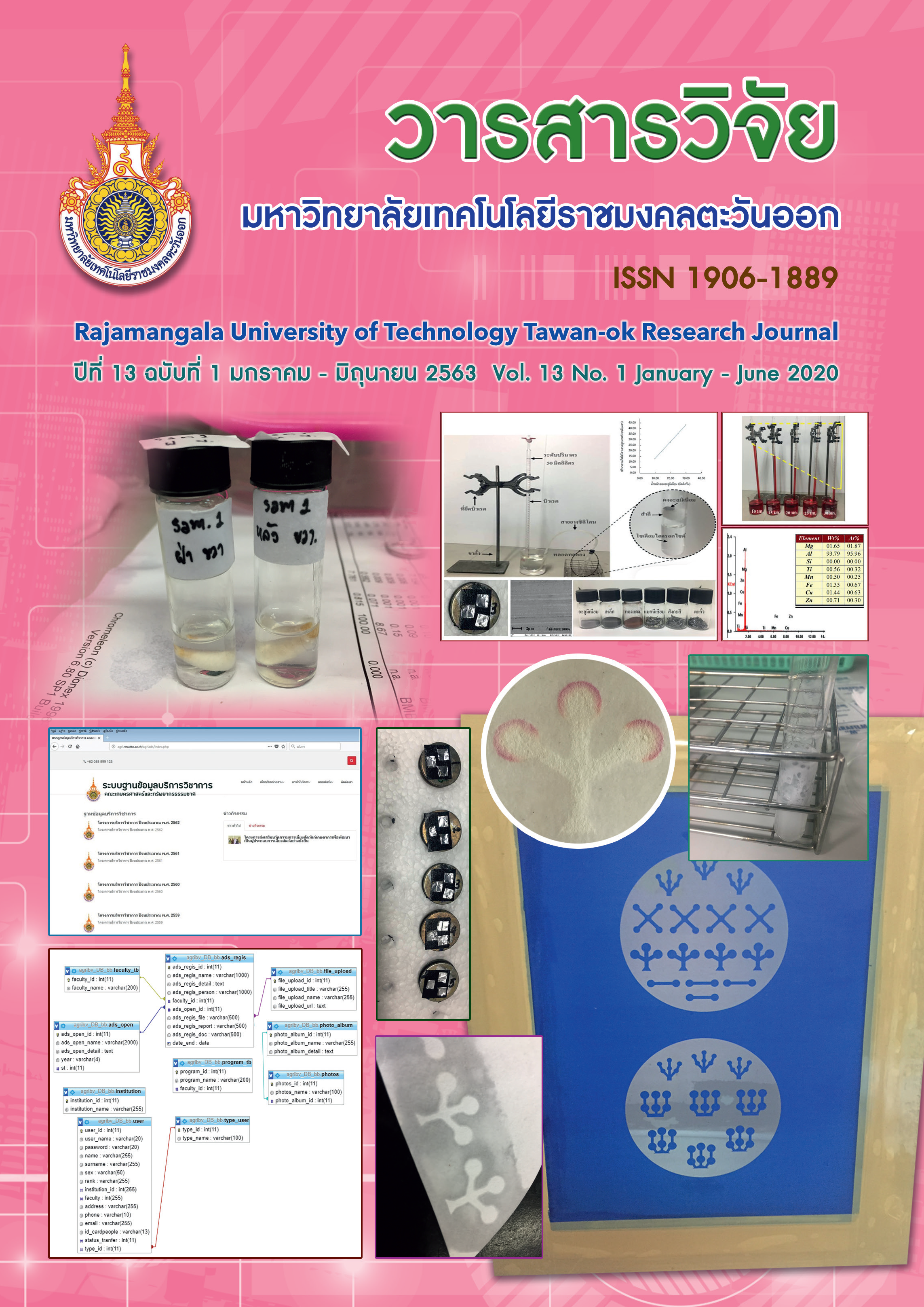Development of a Simple Method for Determination of Aluminium Using Water Replacement by Hydrogen Gas
Main Article Content
Abstract
In this work, a method for quantitative analysis of aluminium using water replacement by hydrogen gas created from the reaction between aluminum and sodium hydroxide solution was developed. In addition, simple glassware was used in the developed method in order to apply as a prototype experimental setup for student learning of “quantitative analysis”. Herein, the optimum conditions of sodium hydroxide concentration, volume of water in the beaker and length of tubing and analytical characteristics were investigated. Under the optimum conditions, the results showed that the linearity was in the range of 10 - 30 mg with the standard equation of y = 1.5079x – 1.8504 (r2 = 0.9993). Limit of detection (LOD) and Limit of quantitation (LOQ) were 1.78 and 2.70 mg, respectively. Furthermore, the proposed method was successfully applied for determination of aluminium in commercial aluminium foils. The proposed method was validated against SEM/EDX as a standard method. The paired t-test showed that the results of the both methods were not significantly different at 95% confidence (tstat = 1.344 and tcrit = 2.784).
Article Details
References
Chaitiamwong, S. 2007. Analytical Chemistry Laboratory. Chaulalongkorn University Printing House, Bangkok. (in Thai)
Chavanasporn, W., C. Randorn, and K. Thampanishvong. 2011. An Analysis of Hydrogen Generation from Recyclable Aluminium Cans. Journal of Environmental Management. 7(1): 43-58.
Costa, B.E.d.S., N.M.M. Coelho and L.M. Coelho. 2015. Determination of arsenic species in rice samples using CPE and ETAAS. Food Chemistry. 178(1): 89-95.
Cutima K. 2018. General Chemistry 2. 14th ed. Chulalongkorn University Printing House, Bangkok. (in Thai)
Fathi, M.R., N. Pourreza and Z. Ardan. 2011. Determination of aluminium in food samples after preconcentration as aluminon complex on microcrystalline naphthalene by spectrophotometry. Química Nova. 34(3): 404-407.
Huseyinli, A.A., R. Alievaa, S. Haciyevaa and T. Guray. 2009. Spectrophotometric determination of aluminium and indium with 2,2,3,4-tetrahydroxy-3,5-disulphoazobenzene. Journal of Hazardous Materials. 163(1): 1001-1007.
Iron and steel Institute of Thailand. 2015. Aluminium. http://iiu.isit.or.th/th/reports/InDepth%20Research%20Report/download.aspx?Content.pdf. Accessed 1 May 2018.
Iwakoshi, K., Y. Shiozawa, Y. Yamajima, I. Baba, K. Monma, C. Kobayashi and T. Sasamoto. 2019. Determination of nine preservatives in processed foods using a modified QuEChERS extraction and quantified by HPLC-PDA. Food Additives & Contaminants: Part A. 36(7): 1020-1031.
Khanhuathon, Y., W. Siriangkhawut, P. Chantiratikul and K. Grudpan. 2015. Spectrophotometric method for determination of aluminium content in water and beverage samples employing flow-batch sequential injection system. Journal of Food Composition and Analysis. 41(1): 45-53.
Liu, S., P. Zhang, H. Liu, W. Wang, and K. Lian. 2013. Determination of trace mercury in cosmetics by suspension-sampling hydride generation atomic fluorescence spectrometry. Asian Journal of Chemistry. 25(13): 7315-7318.
Lopez, F.F., C. Cabrera, M.L. Lorenzo and M.C. Lopez. 2002. Aluminium content of drinking waters, fruit juices and soft drinks: contribution to dietary intake. The Science of the Total Environment. 292(1): 205-213.
Muncharoen, S., J. Sitanurak, W. Tiyapongpattana, N. Choengchan, N. Ratanawimarnwong, S. Motomizu, P. Wilairat and D. Nacapricha. 2009. Quality control of gasohol using a micro-unit for membraneless gas diffusion. Microchim Acta. 164(1): 203-210.
Noordiana, N., A.B. Fatimah and Y. C. B. Farhana. 2011. Formaldehyde content and quality characteristics of selected fish and seafood from wet markets. International Food Research Journal. 18(1): 125-136.
Oliveira Arias, de J.L., R.B. Rocha, A.L.Q.S. Santos, L.C. Marube, L. Kupski, S.S. Caldas and E.G. Prime. 2019. Fast and simple method of simultaneous preservative determination in different processed foods by QuEChERS and HPLC-UV: Method development, survey and estimate of daily intake. Food Chemistry. 293(1): 112-119.
Park, J., S. Choi, D. Oh and J-H. Mah. 2017. Simultaneous and rapid analysis of chemical preservatives in processed animal products by ultra-performance liquid chromatography. Food Sci Biotechnol. 27(1): 291-298.
Pourghazi, K., M.D. Diva and S. Karimi. 2017. Extraction, Preconcentration and Spectrometric Determination of Al (III) and Cr (III) Ions using Modified MnFe2O4 Nanoparticles as an Efficient Adsorbent. Nanochem Res. 2(2): 223-229.
Rodrigues, J.L., de C.S. Magalhaes and P.O. Luccas. 2005. Flow injection spectrophotometric determination of Al in hemodialysis solutions. Journal of Pharmaceutical and Biomedical Analysis. 36(1): 1119-1123.
Sahu, R.K. and S.S. Hiremath. 2017. Synthesis of Aluminium Nanoparticles in A Water/Polyethylene Glycol Mixed Solvent using μ-EDM. Materials Science and Engineering. 225(1): 1-8.
Saiyed, S.M. and R. Yokel. 2005. Aluminium content of some foods and food products in the USA, with aluminium food additives. Food Additives and Contaminants. 22(3): 234-244.
Scancar, J., V. Stibilj and R. Milacic. 2004. Determination of aluminium in Slovenian foodstuffs and its leachability from aluminium-cookware. Food Chemistry. 85: 151-157.
Seruga, M., J. Grgi and M. Mandi. 1994. Aluminium content of soft drinks from aluminium cans. Z Lebensm Unters Forsch. 198(1): 313-316.
Siriangkhawut, W., S. Tontrong and P. Chantiratikul. 2013. Quantitation of aluminium content in waters and soft drinks by spectrophotometry using Eriochrome Cyanine R. Research Journal of Pharmaceutical, Biological and Chemical Sciences. 4(3): 1154-1161.
Somnam S. 2014. Analytical Chemistry. 1st ed. Chulalongkorn University Printing House, Bangkok. (in Thai).
Soni, M.G., S.M. White, W.G. Flamm, and G.A. Burdock. 2001. Safety Evaluation of Dietary Aluminum. Regulatory Toxicology and Pharmacology. 33(1): 66-79.
Soylak, M. and A. Aydin. 2011. Determination of some heavy metals in food and environmental samples by flame atomic absorption spectrometry after coprecipitation. Food and Chemical Toxicology. 49(1): 1242–1248.
Supian, S.M., T.L. Ling, L.Y. Heng and K.F. Chong. 2013. Quantitative determination of Al(III) ion by using Alizarin Red S including its microspheres optical sensing material. Analytical Methods. 5(1): 2602-2609.
Sripiirojna, P. 2004. Basic Chemistry 1. 2nd ed. So.Pichit Printing Co.,Ltd, Bangkok. (in Thai)


